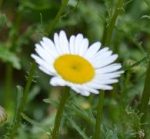 Oxeye daisy is a rhizomatous herbaceous perennial and belongs to the aster family, Asteraceae, that also includes sunflowers, yarrow, and lettuce. It is native to Europe and Asia but was introduced to North America and is now found throughout the US where it grows in lawns, vacant lots, pastures, meadows, rangelands, edges of waterways and along roadsides and railroad tracks. Growing 1-3′ tall from a rhizomatous rootstock, oxeye daisy has a smooth mostly unbranched stem that carries dark green lobed leaves. The lower leaves have slender petioles, are spoon-shaped and up to 5 inches long while the upper leaves are smaller and clasp the stem. The flower heads are up to 2″ across and are borne singly on the tips of the stems from mid summer into fall. Each flower head consists of fifteen to thirty five white ray flowers surrounding a center of yellow disc flowers and are followed by seed heads of one seeded fruits called achenes. A single plant can produce up to 26,000 seeds, most of which can remain viable in the soil for up to six years. The genus name and specific epithet, Leucanthemum, comes from the Greek words leukos meaning white and anthus meaning flower, and refers to the white ray flowers. The specific epithet, Chrysanthemum, comes from the Greek words chrysos meaning golden and anthus meaning flower, referring to the gold disc flowers. The specific epithet, vulgare, is from the Latin word vularis meaning common.
Oxeye daisy is a rhizomatous herbaceous perennial and belongs to the aster family, Asteraceae, that also includes sunflowers, yarrow, and lettuce. It is native to Europe and Asia but was introduced to North America and is now found throughout the US where it grows in lawns, vacant lots, pastures, meadows, rangelands, edges of waterways and along roadsides and railroad tracks. Growing 1-3′ tall from a rhizomatous rootstock, oxeye daisy has a smooth mostly unbranched stem that carries dark green lobed leaves. The lower leaves have slender petioles, are spoon-shaped and up to 5 inches long while the upper leaves are smaller and clasp the stem. The flower heads are up to 2″ across and are borne singly on the tips of the stems from mid summer into fall. Each flower head consists of fifteen to thirty five white ray flowers surrounding a center of yellow disc flowers and are followed by seed heads of one seeded fruits called achenes. A single plant can produce up to 26,000 seeds, most of which can remain viable in the soil for up to six years. The genus name and specific epithet, Leucanthemum, comes from the Greek words leukos meaning white and anthus meaning flower, and refers to the white ray flowers. The specific epithet, Chrysanthemum, comes from the Greek words chrysos meaning golden and anthus meaning flower, referring to the gold disc flowers. The specific epithet, vulgare, is from the Latin word vularis meaning common.
Type: Herbaceous perennial
Bloom: Flower heads of white ray flowers surrounding center of yellow disc flowers from mid summer into fall
Size: 1.3- H x 1-2′ W
Light: Full to part sun
Soil: Average, medium moist to dry, well-drained
Hardiness: Zones 3-9
Care: Confine spread if necessary
Pests and Diseases: None of significance
Propagation:Seed, division
Companion Plants: Coneflower, rudbeckia, bee balm